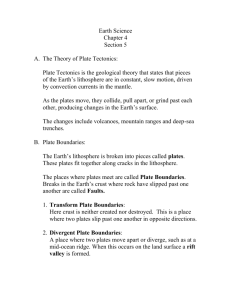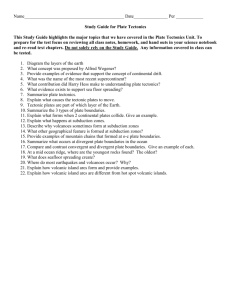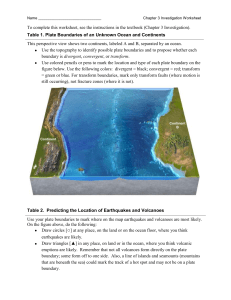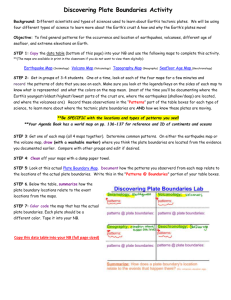The Dynamics of Plate Tectonics Reading
advertisement
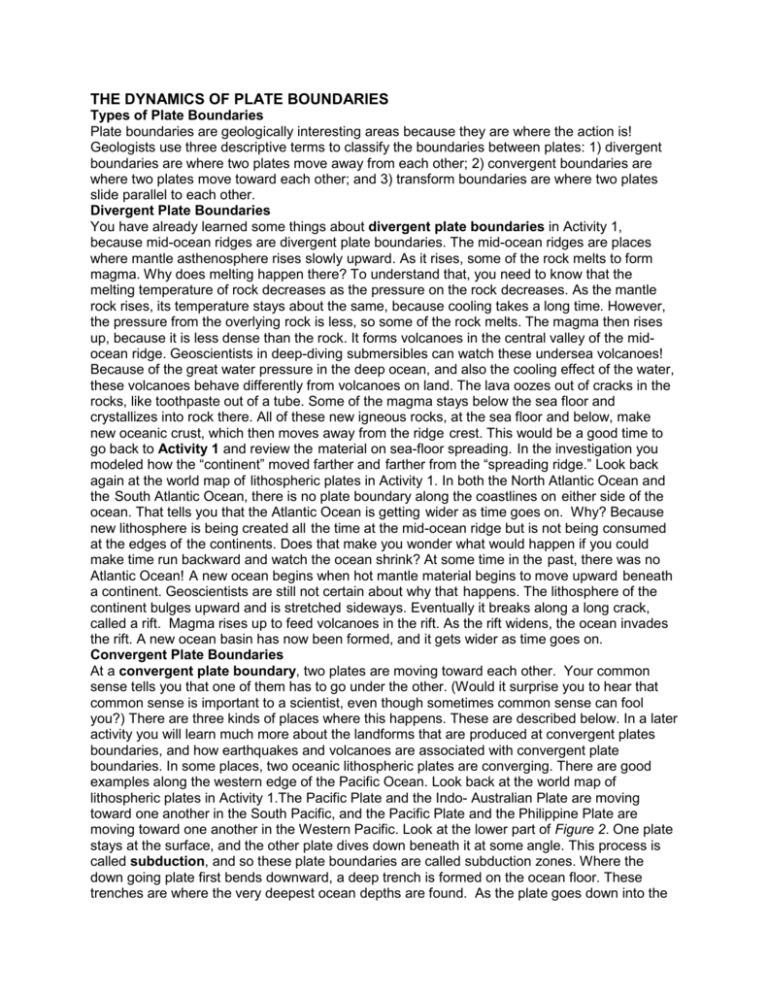
THE DYNAMICS OF PLATE BOUNDARIES Types of Plate Boundaries Plate boundaries are geologically interesting areas because they are where the action is! Geologists use three descriptive terms to classify the boundaries between plates: 1) divergent boundaries are where two plates move away from each other; 2) convergent boundaries are where two plates move toward each other; and 3) transform boundaries are where two plates slide parallel to each other. Divergent Plate Boundaries You have already learned some things about divergent plate boundaries in Activity 1, because mid-ocean ridges are divergent plate boundaries. The mid-ocean ridges are places where mantle asthenosphere rises slowly upward. As it rises, some of the rock melts to form magma. Why does melting happen there? To understand that, you need to know that the melting temperature of rock decreases as the pressure on the rock decreases. As the mantle rock rises, its temperature stays about the same, because cooling takes a long time. However, the pressure from the overlying rock is less, so some of the rock melts. The magma then rises up, because it is less dense than the rock. It forms volcanoes in the central valley of the midocean ridge. Geoscientists in deep-diving submersibles can watch these undersea volcanoes! Because of the great water pressure in the deep ocean, and also the cooling effect of the water, these volcanoes behave differently from volcanoes on land. The lava oozes out of cracks in the rocks, like toothpaste out of a tube. Some of the magma stays below the sea floor and crystallizes into rock there. All of these new igneous rocks, at the sea floor and below, make new oceanic crust, which then moves away from the ridge crest. This would be a good time to go back to Activity 1 and review the material on sea-floor spreading. In the investigation you modeled how the “continent” moved farther and farther from the “spreading ridge.” Look back again at the world map of lithospheric plates in Activity 1. In both the North Atlantic Ocean and the South Atlantic Ocean, there is no plate boundary along the coastlines on either side of the ocean. That tells you that the Atlantic Ocean is getting wider as time goes on. Why? Because new lithosphere is being created all the time at the mid-ocean ridge but is not being consumed at the edges of the continents. Does that make you wonder what would happen if you could make time run backward and watch the ocean shrink? At some time in the past, there was no Atlantic Ocean! A new ocean begins when hot mantle material begins to move upward beneath a continent. Geoscientists are still not certain about why that happens. The lithosphere of the continent bulges upward and is stretched sideways. Eventually it breaks along a long crack, called a rift. Magma rises up to feed volcanoes in the rift. As the rift widens, the ocean invades the rift. A new ocean basin has now been formed, and it gets wider as time goes on. Convergent Plate Boundaries At a convergent plate boundary, two plates are moving toward each other. Your common sense tells you that one of them has to go under the other. (Would it surprise you to hear that common sense is important to a scientist, even though sometimes common sense can fool you?) There are three kinds of places where this happens. These are described below. In a later activity you will learn much more about the landforms that are produced at convergent plates boundaries, and how earthquakes and volcanoes are associated with convergent plate boundaries. In some places, two oceanic lithospheric plates are converging. There are good examples along the western edge of the Pacific Ocean. Look back at the world map of lithospheric plates in Activity 1.The Pacific Plate and the Indo- Australian Plate are moving toward one another in the South Pacific, and the Pacific Plate and the Philippine Plate are moving toward one another in the Western Pacific. Look at the lower part of Figure 2. One plate stays at the surface, and the other plate dives down beneath it at some angle. This process is called subduction, and so these plate boundaries are called subduction zones. Where the down going plate first bends downward, a deep trench is formed on the ocean floor. These trenches are where the very deepest ocean depths are found. As the plate goes down into the mantle asthenosphere, magma is produced at a certain depth. The magma rises up to the ocean floor to form a chain of volcanic islands, called a volcanic island arc. Other subduction zones are located at the edges of continents. Look at the upper part of Figure 2.The west coast of South America, where the Nazca Plate and the South American Plate are converging, is a good example. In places like this, the downgoing plate is always oceanic lithosphere and the plate that remains at the surface is always continental lithosphere. That’s because the continental lithosphere is less dense than the oceanic lithosphere. Ocean–continent subduction is similar in many ways to ocean–ocean subduction, except that the volcanic arc is built at the edge of the continent, rather than in the ocean. The Andes mountain range in western South America is an example of a continental volcanic arc. The third kind of convergent boundary is where two continental lithospheric plates have collided with each other. Think back to the investigation. You were asked what would happen when the “spreading ridge” arrives at the “subduction zone.” If you suspected that the spreading ridge would go down the subduction zone, never to be seen again, you were right! If you had continued the investigation after the spreading ridge had disappeared, what would have happened? As the plate that was on the other side of the spreading ridge was consumed down the subduction zone, the continent on the other side of the ocean would have moved closer and closer to the subduction zone.This is how two continents can come together at a subduction zone. Remember that continental lithosphere is much less dense than the mantle, so continental lithosphere cannot be subducted. The subduction stops! The continent that was coming along toward the subduction zone keeps working its way under the other continent, for hundreds of kilometers, until finally the friction between the two continents is so great that plate movement stops. The zone where two continents have met and become welded into a single continent is called a suture zone. There is only one good example on today’s Earth: the Indian Plate has collided with the Eurasian Plate and is still working its way under it. There is a good reason why the Tibetan Plateau is the largest area of very high elevations in the world: the continental lithosphere is much thicker there because one continent has moved under another. Transform Plate Boundaries At transform boundaries, plates slide past one another. The surface along which the plates slide is called a transform fault. As you saw in Activity 1 in the material about mid-ocean ridges, transform faults connect the offsets along mid-ocean spreading ridges. Most are short, but a few are very long. The most famous transform fault forms the boundary between the North American Plate and the Pacific Plate, in California. It is several hundred kilometers long. You can see from the map in Figure 4 that the San Andreas Fault connects short segments of spreading ridges at its northern and southern ends. The movement along the transform fault is limited to the distance between the two segments of ridge crest. Check Your Understanding, write question and answer in journal 1. Name the three types of boundaries between lithospheric plates. 2. How and where are rift valleys formed? 3. How can ocean basins change in size? 4. Convergent plate boundaries can be in three different settings. What are they? 5. Describe subduction. 6. Why is it that transform faults can be used to figure out the directions of plate movements? Why can’t subduction zones also be used for that? 7. What happens when two continents collide along a convergent plate boundary? Geo Words Define each of the 7 words in your journal: divergent plate boundary convergent plate boundary suture zone transform fault Don’t forget to write a summary! rift valley subduction transform plate boundary The transform fault extends only between Points 1 and 2.To the left of Point 1, Plate A is in contact with itself along the east-west line, and to the right of Point 2, Plate B is in contact with itself along the east-west line. Since the plates are rigid, there is no slipping movement along the east-west lines, which are like “dead” transform faults! Activity 2 Plate Boundaries and Plate Interactions EarthComm subduction zone Canada United States Mexico relative motion of North American plate relative motion of Pacific plate Explorer ridge Juan de Fuca ridge Blanco fracture zone Mendocino fracture zone Molokai fracture zone Murray fracture zone San Francisco East Pacific rise Los Angeles Figure 4 Plates showing a transform boundary. transform fault ridge crest ridge crest fracture zone plate A plate B plate A plate B 1 2 Figure 5 Sketch map of a mid-ocean ridge, showing segments of the ridge crest offset by transform faults.

